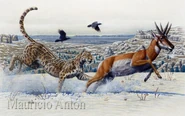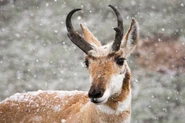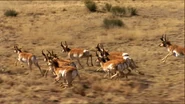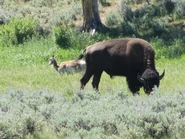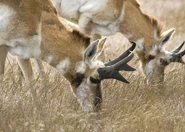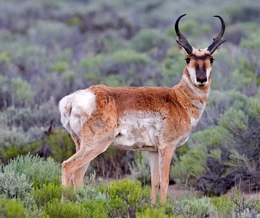
Pronghorn Antelope Cabin Lake Road, Fort Rock, Oregon.
The pronghorn (Antilocapra americana) is a species of artiodactyl mammal indigenous to interior western and central North America. Though not an antelope, it is often known colloquially in North America as the prong buck, pronghorn antelope, or simply antelope because it closely resembles the true antelopes of the Old World and fills a similar ecological niche due to parallel evolution.
It is the only surviving member of the family Antilocapridae. During the Pleistocene period, about 12 antilocaprid species existed in North America. Three other genera existed when humans entered North America (Capromeryx, Stockoceros and Tetrameryx), but are now extinct. As a member of the superfamily Giraffoidea, the pronghorn's closest living relatives are the giraffes and okapi. The Giraffoidea are in

Pronghorn female in Wyoming
turn members of the infraorder Pecora, making pronghorns more distant relatives of the Cervidae (deer) and Bovidae (cattle, goats, sheep, and antelope), among others.
Description[]
Pronghorns have distinct white fur on their rumps, sides, breasts, bellies, and across their throats. Adult males are 1.3–1.5 m (4 ft 3 in–4 ft 11 in) long from nose to tail, stand 81–104 cm (32–41 in) high at the shoulder, and weigh 40–65 kg (88–143 lb). The females are the same height as males, but weigh 34–48 kg (75–106 lb). The feet have two hooves, with no dewclaws. Their body temperature is 38 °C (100 °F).
Each "horn" of the pronghorn is composed of a slender, laterally flattened blade of bone that grows from the frontal bones of the skull, forming a permanent core. As in the Giraffidae, skin covers the bony cores, but in the pronghorn, it develops into a keratinous sheath which is shed and regrown on an annual basis. Unlike the horns of the family Bovidae, the horn sheaths of the pronghorn are branched, each sheath possessing a forward-pointing tine (hence the name pronghorn). Males have a horn sheath about 12.5–43 cm (4.9–16.9 in) (average 25 cm (9.8 in)) long with a prong. Females have smaller horns that range from 2.5–15.2 cm (1–6 in) (average 12 centimetres (4.7 in)) and sometimes barely visible; they are straight and very rarely pronged.[17] Males are further differentiated from females in having a small patch of black hair at the angle of the mandible. Pronghorns have a distinct, musky odor. Males mark territory with a preorbital scent gland which is located on the sides of the head. They also have very large eyes with a 320° field of vision. Unlike deer, pronghorns possess a gallbladder.
The pronghorn is the fastest land mammal in the Western Hemisphere, being built for maximum predator evasion through running. The top speed is very hard to measure accurately and varies between individuals; it can run 35 mph for 4 mi (56 km/h for 6 km), 42 mph for 1 mi (67 km/h for 1.6 km), and 55 mph for 0.5 mi (88.5 km/h for 0.8 km). It is often cited as the second-fastest land animal, second only to the cheetah. It can, however, sustain high speeds longer than cheetahs. University of Idaho zoologist John Byers has suggested the pronghorn evolved its running ability to escape from extinct predators such as the American cheetah, since its speed greatly exceeds that of extant North American predators. Compared to its body size, the pronghorn has a large windpipe, heart, and lungs to allow it to take in large amounts of air when running. Additionally, pronghorn hooves have two long, cushioned, pointed toes which help absorb shock when running at high speeds. They also have an extremely light bone structure and hollow hair. Pronghorns are built for speed, not for jumping. Their ranges are sometimes affected by sheep ranchers' fences. However, they can be seen going under fences, sometimes at high speed. For this reason, the Arizona Antelope Foundation and others are in the process of removing the bottom barbed wire from the fences, and/or installing a barbless bottom wire. The pronghorn has been observed to have at least 13 distinct gaits, including one reaching nearly 7.3 m (8.0 yd) per stride.
Range and Ecology[]
Pronghorns were brought to scientific notice by the Lewis and Clark Expedition, which found them in what is now South Dakota. Their range extends from southern Saskatchewan and Alberta in Canada south through the United States (southwestern Minnesota and central Texas west to coastal southern California) and northern Baja California Sur, to Sonora and San Luis Potosí in northern Mexico.
The subspecies known as the Sonoran pronghorn (A. a. sonoriensis) occurs in Arizona and Mexico. Other subspecies include the Mexican pronghorn (A. a. mexicana), the Oregon pronghorn (A. a. oregona), and the critically endangered Baja California pronghorn (A. a. peninsularis).
Pronghorns prefer open, expansive terrain at elevations varying between 900 and 1,800 m (3,000 and 5,900 ft), with the densest populations in areas receiving around 25–40 cm (9.8–15.7 in) of rainfall per year. They eat a wide variety of plant foods, often including plants unpalatable or toxic to domestic livestock (sheep and cattle), though they also compete with them for food. In one study, forbs comprised 62% of their diet, shrubs 23%, and grasses 15%, while in another, cacticomprised 40%, grass 22%, forbs 20%, and shrubs 18%. Pronghorns also chew and eat (ruminate) cud, which is their own partially digested food. Healthy pronghorn populations tend to stay within 5.0–6.5 km (3.1–4.0 mi) of water. An ongoing study by the Lava Lake Institute for Science and Conservation and the Wildlife Conservation Society shows an overland migration route that covers more than 160 mi (260 km).[28] The migrating pronghorn start travel from the foothills of the Pioneer Mountains through Craters of the Moon National Monument to the Continental Divide. Dr. Scott Bergen of Wildlife Conservation Society says, "This study shows that pronghorn are the true marathoners of the American West. With these new findings, we can confirm that Idaho supports a major overland mammal migration - an increasingly rare phenomenon in the U.S. and worldwide."
Cougars, wolves, coyotes, and bobcats are their major predators (if they could ever catch them). Golden eagles have been reported to prey on fawns.
Social Behavior and Reproduction[]
Pronghorns form mixed-sex herds in the winter. In early spring, the herds break up, with young males forming bachelor groups, females forming their groups, and adult males living solitarily. Some female bands share the same summer range, and bachelor male bands form between spring and fall. Females form dominance hierarchies with few circular relationships. Dominant females aggressively displace other females from feeding sites.
Adult males either defend a fixed territory that females may enter, or defend a harem of females. A pronghorn may change mating strategies depending on environmental or demographic conditions. Where precipitation is high, adult males tend to be territorial and maintain their territories with scent marking, vocalizing, and challenging intruders. In these systems, territorial males have access to better resources than bachelor males. Females also employ different mating strategies. "Sampling" females visit several males and remain with each for a short time before switching to the next male at an increasing rate as oestrus approaches. "Inciting" females behave as samplers until oestrus and then incite conflicts between males, watching and then mating with the winners. Before fighting, males try to intimidate each other. If intimidation fails, they lock horns and try to injure each other. "Quiet" females remain with a single male in an isolated area throughout oestrus. Females continue this mating behavior for two to three weeks.
When courting an estrous female, a male pronghorn approaches her while softly vocalizing and waving his head side to side, displaying his cheek patches. The scent glands on the pronghorn are on either side of the jaw, between the hooves, and on the rump. A receptive female remains motionless, sniffs his scent gland, and then allows the male to mount her.
Pronghorns have a gestation period of 7–8 months, which is longer than is typical for North American ungulates. They breed in mid-September, and the doe carries her fawn until late May. This gestation period is around six weeks longer than that of the White-Tailed Deer. Females usually bear within a few days of each other. Twin fawns are common. Newborn pronghorns weigh 2–4 kg (4.4–8.8 lb), most commonly 3 kg (6.6 lb). In their first 21–26 days, fawns spend time hiding in vegetation. Fawns interact with their mothers for 20–25 minutes a day and this continues even when the fawn joins a nursery. The females nurse, groom, and lead their young to food and water, as well as keep predators away from them. Females usually nurse the young about three times a day. Males are weaned 2–3 weeks earlier than females. Sexual maturity is reached at 15 to 16 months, though males rarely breed until three years old. Their lifespan is typically up to 10 years, rarely 15 years.
